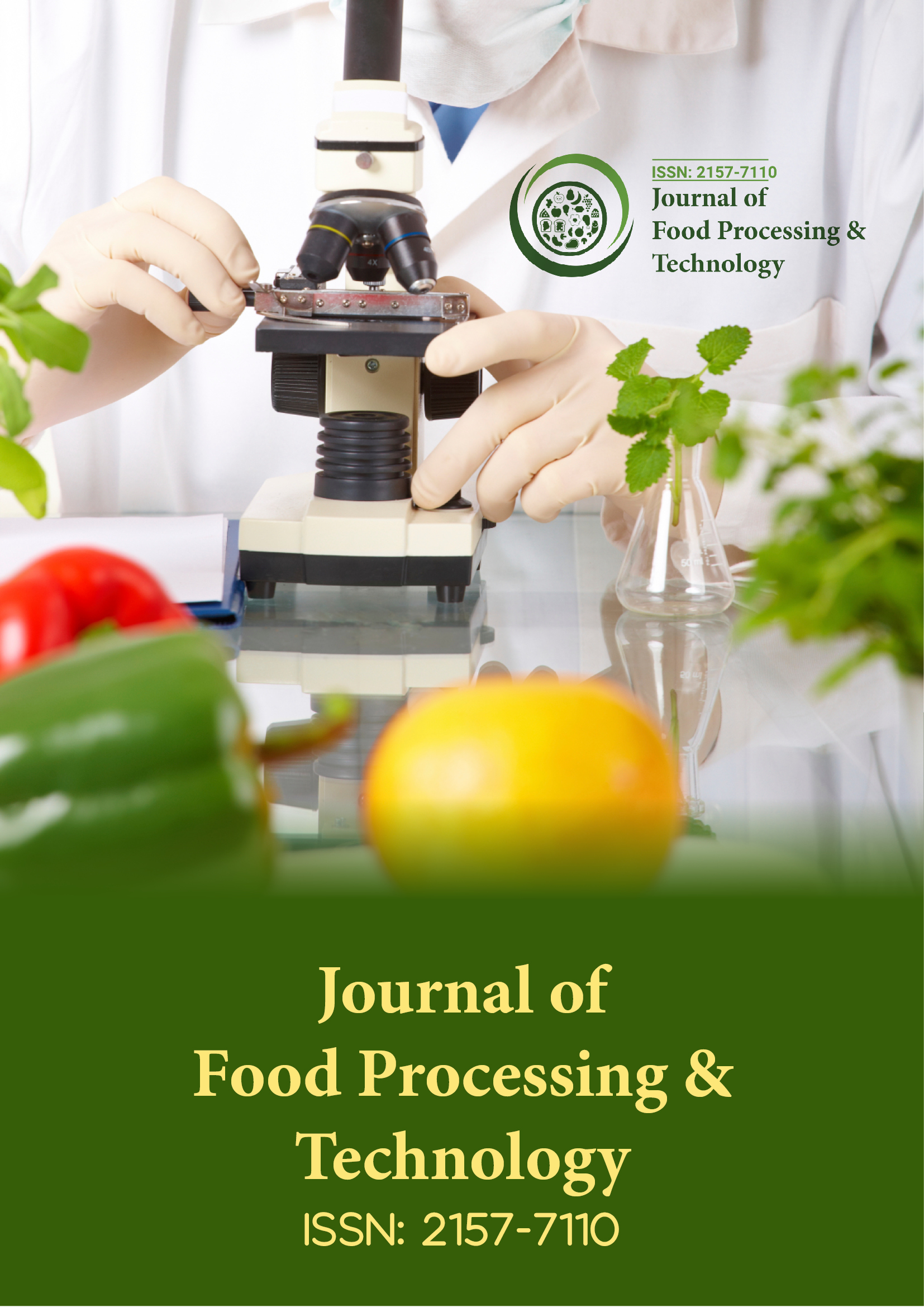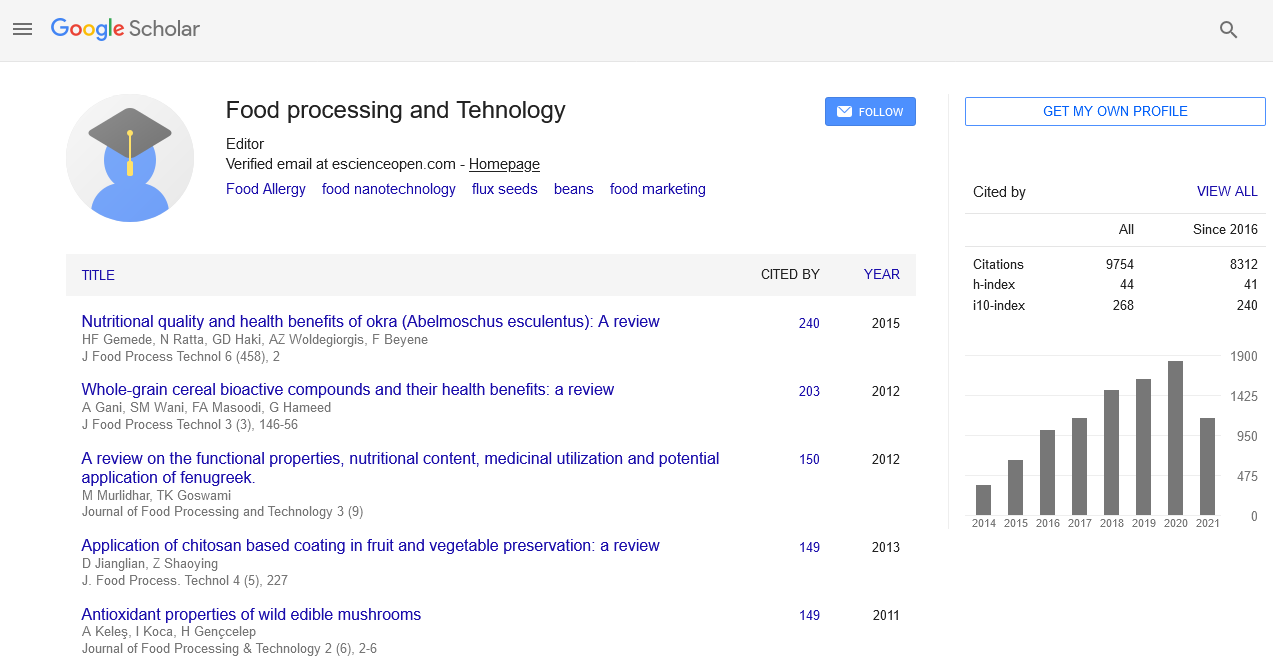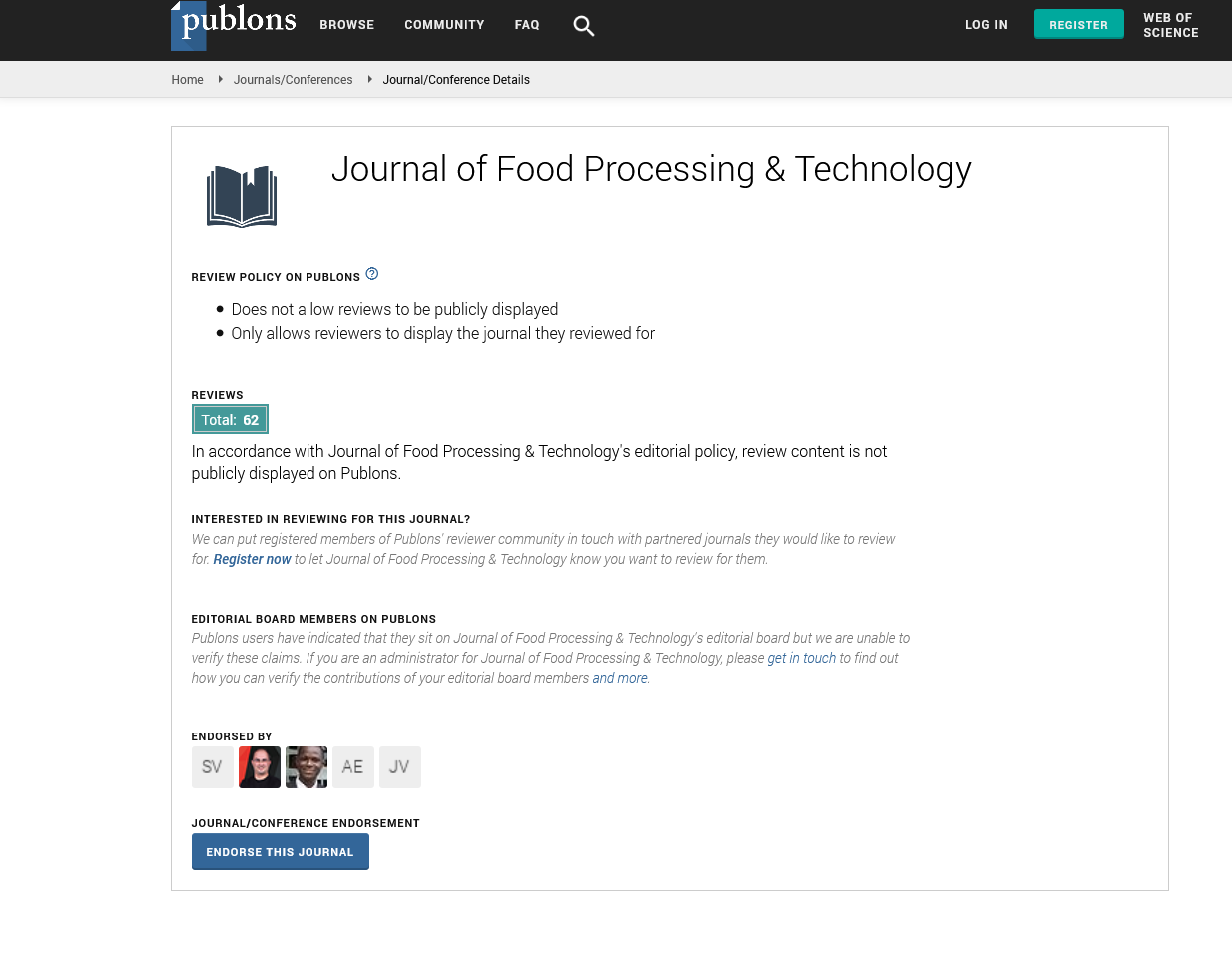Indexed In
- Genamics JournalSeek
- Academic Keys
- JournalTOCs
- China National Knowledge Infrastructure (CNKI)
- Access to Global Online Research in Agriculture (AGORA)
- Centre for Agriculture and Biosciences International (CABI)
- RefSeek
- Directory of Research Journal Indexing (DRJI)
- Hamdard University
- EBSCO A-Z
- OCLC- WorldCat
- Scholarsteer
- SWB online catalog
- Publons
- Euro Pub
- Google Scholar
Useful Links
Share This Page
Journal Flyer

Open Access Journals
- Agri and Aquaculture
- Biochemistry
- Bioinformatics & Systems Biology
- Business & Management
- Chemistry
- Clinical Sciences
- Engineering
- Food & Nutrition
- General Science
- Genetics & Molecular Biology
- Immunology & Microbiology
- Medical Sciences
- Neuroscience & Psychology
- Nursing & Health Care
- Pharmaceutical Sciences
Commentary - (2025) Volume 16, Issue 1
Nanotechnology Applications in Modern Food Processing Systems
Xinyi Zhao*Received: 27-Jan-2025, Manuscript No. JFPT-25-29172; Editor assigned: 29-Jan-2025, Pre QC No. JFPT-25-29172; Reviewed: 12-Feb-2025, QC No. JFPT-25-29172; Revised: 18-Feb-2025, Manuscript No. JFPT-25-29172; Published: 26-Feb-2025, DOI: 10.35248/2157-7110.25.16.1143
Description
Nanotechnology, the science of manipulating matter at the nanoscale (typically 1 to 100 nanometers), is transforming the landscape of modern food processing systems. This emerging field offers a range of innovative solutions that address challenges in food safety, quality enhancement, shelf-life extension and nutritional delivery. As consumers increasingly demand safe, minimally processed and health-promoting foods, the application of nanotechnology is rapidly gaining momentum in both research and industrial settings. At the heart of nanotechnology’s impact is its ability to modify and control food components at the molecular level, leading to the development of novel materials and processes that were previously unattainable. The unique properties of nanomaterials such as high surface area, increased reactivity and enhanced permeability enable them to perform functions that macro or microscale materials cannot. In food processing, these properties are harnessed to improve nutrient delivery, texture, flavor retention and food safety.
One of the most promising applications of nanotechnology in food processing is nanoencapsulation. This technique involves enclosing bioactive substances such as vitamins, antioxidants, probiotics, or essential oils within nanocarriers made of biocompatible materials. Nanoencapsulation offers several advantages over conventional encapsulation methods, including better protection against degradation, improved solubility in aqueous systems and controlled release during digestion. For example, omega-3 fatty acids, which are sensitive to oxidation and have an unpleasant taste, can be incorporated into beverages using nanoemulsions that mask flavor and increase bioavailability without altering product appearance or texture. Similarly, nanoencapsulated curcumin or resveratrol can be more efficiently absorbed in the gastrointestinal tract, enhancing their health-promoting effects.
Nanotechnology also plays a crucial role in antimicrobial food preservation. Metallic nanoparticles such as silver, zinc oxide and titanium dioxide exhibit strong antimicrobial activity against a wide spectrum of foodborne pathogens and spoilage microorganisms. These nanoparticles can be incorporated directly into food packaging materials or applied as coatings on food surfaces to prevent microbial growth. Their mechanism of action includes disrupting cell membranes, generating reactive oxygen species and interfering with microbial metabolic processes. As a result, products like fresh produce, dairy, meat and baked goods can enjoy extended shelf life and reduced risk of contamination without the use of synthetic chemical preservatives.
In the realm of packaging, nanotechnology enables the development of intelligent and active packaging systems. Active packaging incorporates nanomaterials that interact with the food or its environment to maintain quality for example, by absorbing oxygen, releasing antimicrobials, or scavenging ethylene gas to slow ripening. Intelligent packaging, on the other hand, integrates nanosensors that detect changes in temperature, humidity, pH, or gas composition and can signal spoilage or contamination through visual indicators like color changes. Such packaging innovations not only enhance food safety and reduce waste but also empower consumers and retailers to make informed decisions about product freshness and usability.
Another significant application of nanotechnology is in food structure and texture modification. Nanostructured emulsions, foams and gels can mimic the mouthfeel of fat-rich foods while significantly reducing fat content. This opens avenues for developing healthier versions of traditionally high-fat products without compromising taste or sensory appeal. In addition, nanostructures can be engineered to respond to temperature, pH, or enzymes, allowing for controlled flavor release and tailored food experiences.
Nanotechnology also facilitates rapid and sensitive detection of contaminants in food. Nanosensors and nano-biosensors based on carbon nanotubes, quantum dots, or gold nanoparticles can detect trace amounts of pathogens, toxins, allergens, pesticides, or chemical residues in real time. These tools are significantly faster and more accurate than conventional laboratory-based methods, enabling food manufacturers to monitor quality at every stage of processing and supply chain management. This real-time detection capability plays a vital role in preventing foodborne outbreaks and ensuring regulatory compliance.
Despite its vast potential, the integration of nanotechnology in food processing comes with challenges. One of the primary concerns is safety specifically, the health implications of ingesting engineered nanoparticles. While many studies suggest that food-grade nanomaterials are safe within certain limits, more long-term toxicological data is needed to fully understand their behavior in the human body and their interaction with biological systems. Regulatory bodies around the world are in the process of evaluating and establishing guidelines for the use of nanomaterials in food and packaging, but harmonized global standards are still lacking. Transparency in labeling and clear communication regarding the use of nanotechnology in food products are essential for gaining consumer trust.
Consumer acceptance is another critical factor. Misinformation or lack of understanding about nanotechnology may lead to skepticism or resistance, even if the products are demonstrably safe and beneficial. Therefore, it is important to engage in public education and dialogue that clearly explains the science behind food nanotechnology, its advantages and the safety measures in place. Looking ahead, the future of nanotechnology in food processing is promising. Continued research and development are expected to lead to more sustainable, cost-effective and biocompatible nanomaterials. The integration of nanotechnology with other emerging fields such as artificial intelligence, biotechnology and smart manufacturing will likely result in more personalized and adaptive food systems. As the industry moves toward cleaner labels, reduced waste and enhanced nutrition, nanotechnology is poised to become a central pillar in achieving the goals of modern food science and technology.
Citation: Zhao X (2025). Nanotechnology Applications in Modern Food Processing Systems. J Food Process Technol.16: 1143.
Copyright: © 2025 Zhao X. This is an open access article distributed under the terms of the Creative Commons Attribution License, which permits unrestricted use, distribution and reproduction in any medium, provided the original author and source are credited.


